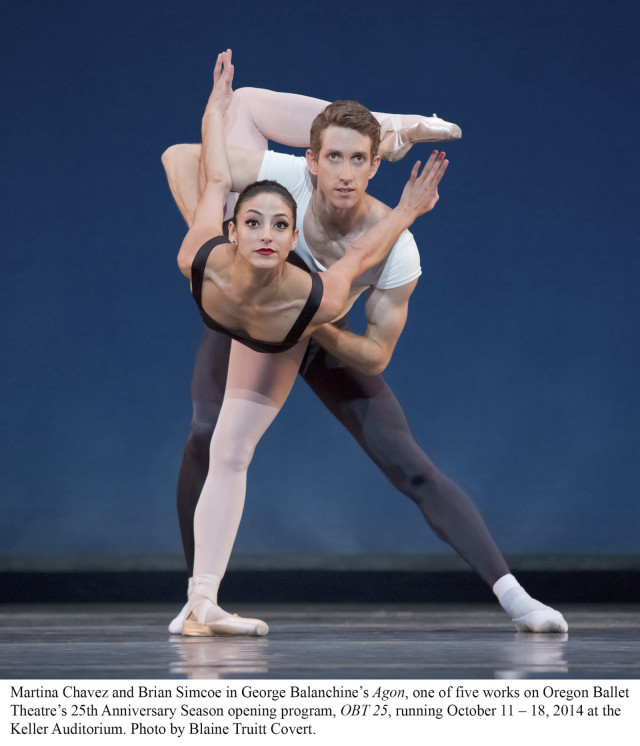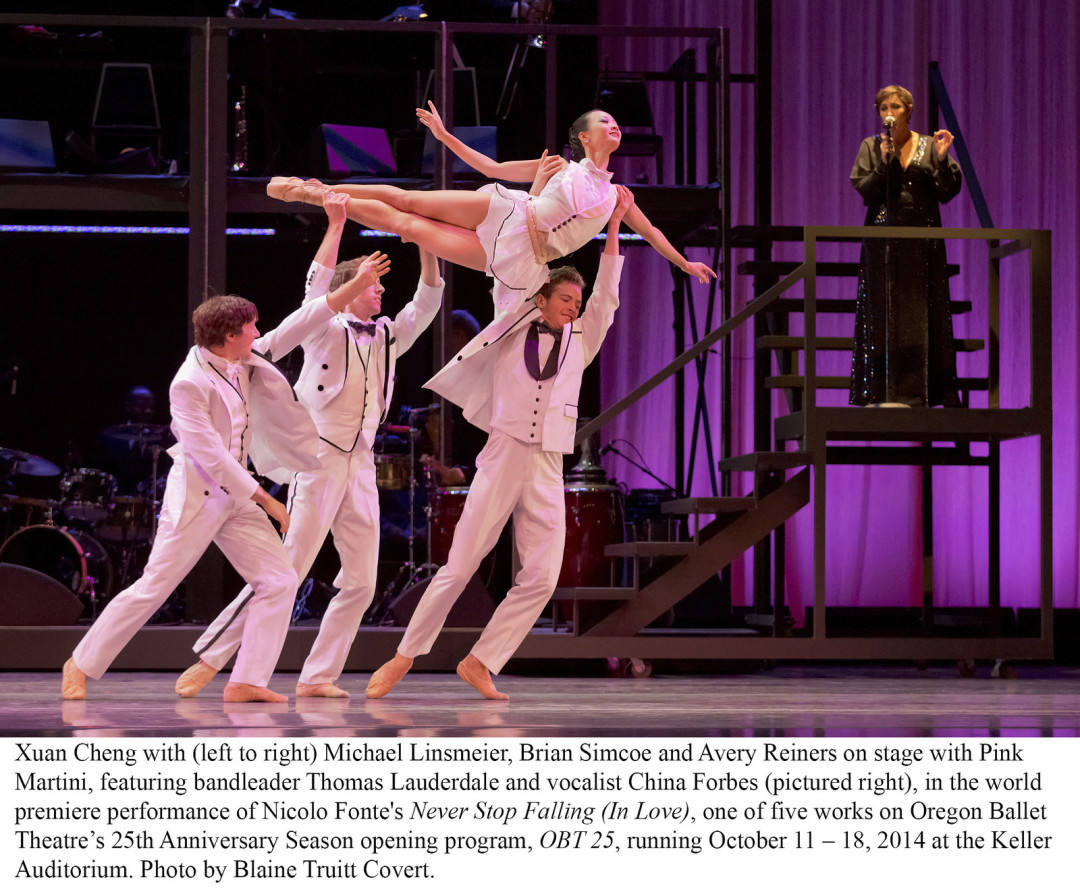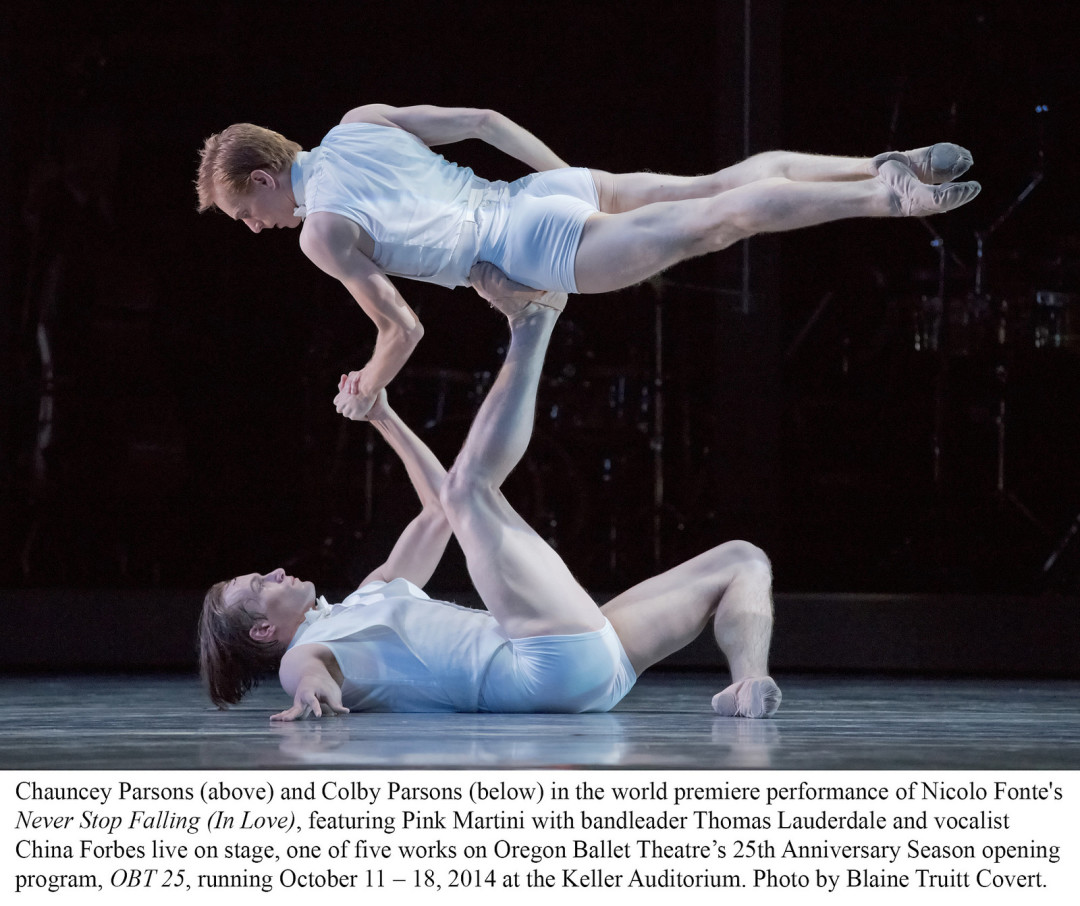Review: Oregon Ballet Theatre Turns 25 with a Stage Extravaganza

Anniversaries are often an excuse to look backward, but the best moments of OBT’s kickoff program for its 25th season, which meandered from crisp showcases of virtuosity to navel-gazing speechifying, were all about the future—first and foremost a big, joyous new collaboration with Portland’s own Pink Martini from longtime choreographic conspirator Nicolo Fonte.
As has become a bit of a tradition with the company—or maybe a welcome boast about its technical prowess—the program launched with a Balanchine chestnut. This outing it was the artful, icy dance cadres of Agon, a 1957 work famous for stripping away ballet’s romanticism (and tutus) in favor of a look under the hood of the dance machine. Set to Igor Stravinsky’s punishing modern score, quartets, trios, and duos of dancers attack complicated traveling moves, flexed heel jumps, and mind-bendingly complicated partnering sequences.
Some dancers’ smiles looked pasted on as they struggled to keep time with the choreography. But longtime company member Candace Bouchard shined with a sly, sexy confidence that extended to every wrist flip and shoulder drop during a mesmerizing solo and trio section set to a castanet-clicking score that sounded like Flamenco on Tatooine. Minutes later, Martina Chavez and Brian Simcoe nailed the piece’s toughest pas de deux, a deceptively cool piece of choreography peppered with blind drops that flirt with brain injury and a lasting image of Simcoe firmly bending Chavez’s lithe body into a sort of standing swan origami. (Chavez was promoted to soloist after opening weekend and will reprise her two leading roles this coming weekend.)

Next up, a trio of brief duets entitled Love x 3, which spotlit duets from three of the biggies that have defined OBT in the last quarter-century: lauded choreographer Trey McIntyre (2013’s Robust American Love), former OBT artistic director Christopher Stowell (2011’s Carmen), and founding artistic director James Canfield (1989's Romeo & Juliet). Sadly, the stilted, ill-conceived live introductions for each piece, which enlisted everyone from Canfield-era dancer Tracy Taylor to former Mayor Sam Adams, dragged on longer than the works themselves. A video montage of each choreographer's work with OBT would have better served the audience to introduce the dances.
OBT 25
Keller Auditorium
October 17–18
McIntryre’s extremely short Fleet Foxes number was a wry, energetic delight of oddball partnering and effortless musicality. The lovers wore shin-length long coats; the tails of which were tugged, twirled, and twisted like extra limbs. While Canfield’s Shakespearean excerpt was lush and lovely, it seemed like a missed opportunity to welcome back a larger than life dancemaker who made his (and OBT’s name) with genre-busting rock ballets (Go Ask Alice, etc.) with a straight take on a classic performed by nearly every company and school in the country.
Stowell, a classicist to the core, fared the best with his cheeky snippet of operatic Bizet—the bit where a shackled Carmen seduces prison guard Jose. Beloved ballerina Alison Roper, who retired last year after 17 years with OBT, returned to the stage as the blowsy firestarter, proving once and for all she can outdance most comers literally with two hands tied behind her back. Sultry, funny, and filled with visual puns, it was Stowell as his romantic best. You wish you could sit back and watch the whole ballet.

In truth, the entire night seemed a warm up to Fonte's Never Stop Falling (In Love), which featured the entire Pink Martini pack live onstage. It’s impossible to upstage the genre-spanning outfit and, wisely, Fonte doesn't try. Instead, he created a lively, lovable series of vignettes that transmuted the band’s sexy continent-trotting beats and singer China Forbes’ otherworldly trills to body music. The tone was set from the moment the spotlight beamed on Martina Chavez’s tux vest and Thomas Lauderdale’s grand piano—this is all about old school grandeur and glamour paired with contemporary movement: flapping white tailcoats and frothy short tulle skirts, beautiful women lifted high above armies of men, waltzing couples swirling in time, the works.
Fonte says he envisioned his survey of Martini’s catalog as set in a sort of “Hotel of Love,” but in its clunkiest moments, the piece was more reminiscent of cruise ship entertainment—bloated with bodies in blinding white formal attire and rushed transitions. But as those distracting jackets were tossed away and the dancers peeled away into smaller groups, the piece simply got stronger and stronger.

Watching the dancers sweat through Fonte's choreography during OBT Exposed in Pioneer Courthouse Square last August, the dancemaker’s athletic fluidity and knack for pairing jaunty little accents to musical quirks was already apparent. It blossoms in full during Never Stop’s most stripped down number, “Hey Eugene,” where Forbes stands center stage sing-narrating a bizarre one night stand amidst an oblivious sea of men gliding through sinuous rolls and wild leaps. Jordan Kindell, who first made a splash with his pas de deux with Roper during her farewell performance last spring, was again the standout here; his lower center of gravity and muscular grace lended him a sort of raw power that makes him impossible to ignore—a jaguar among swan princes.
The work’s other defining moment also belonged to the men; a sort of trio for principal dancer Chauncey Parsons, Colby Parsons, and Lauderdale’s piano. The elegiac choreography highlighted Chauncey’s delicate lines as well as Colby’s brute strength. At one point, Colby laid on his back on the floor with Chauncey above him, hovering four feet in the air like a magician's trick—their only points of connection a sturdy forearm clasp and a foot socked into a hip joint. It was one of those moment where practice, technique, and creativity merge to beautiful affect. It’s a balancing act OBT has been pulling off for a quarter-century now. And, I suspect, for decades to come.




